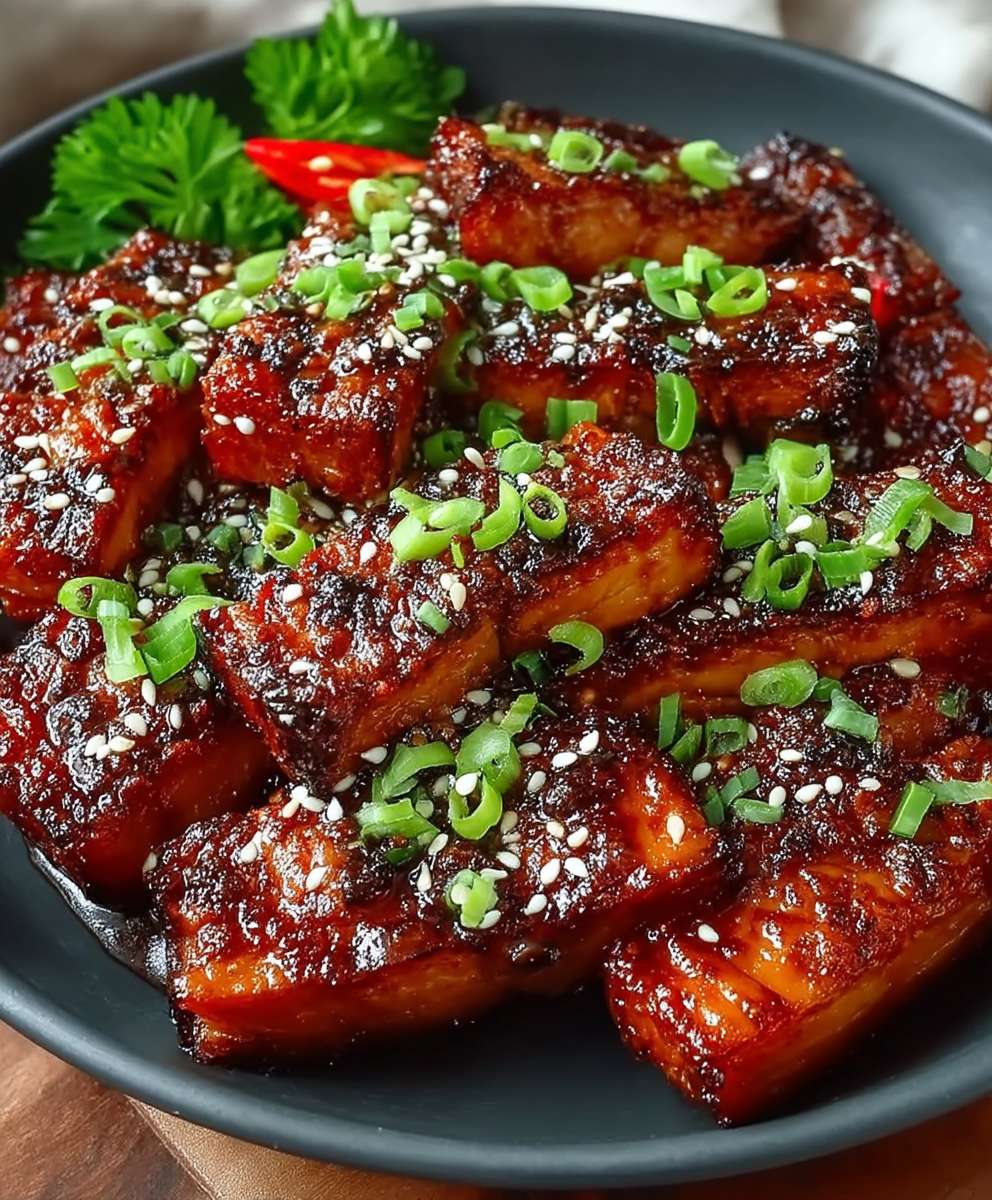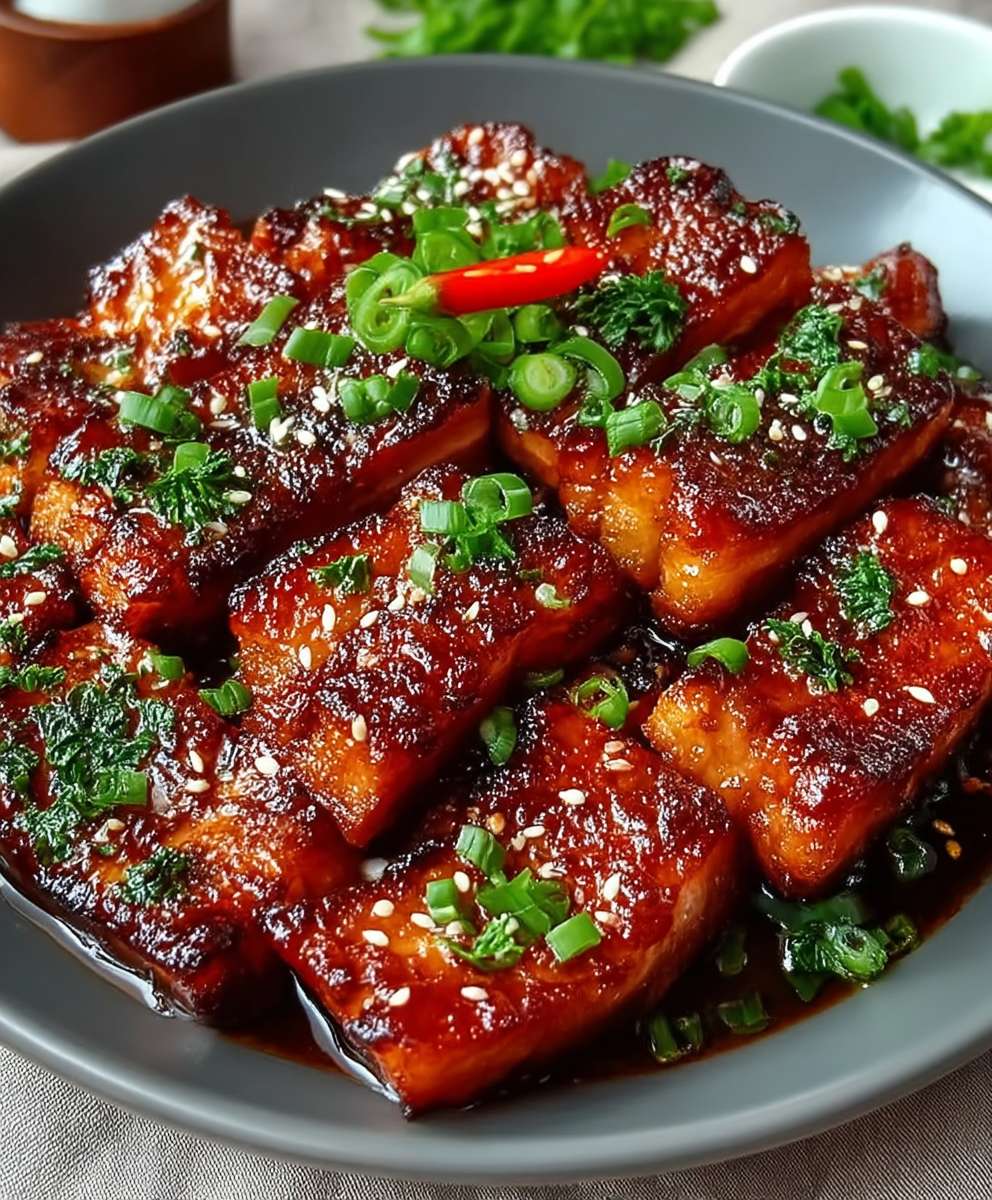Korean pork belly, or samgyeopsal, is more than just a meal; it’s an experience! Imagine sizzling, perfectly marbled pork, the aroma filling the air, as you gather around a table with friends and family. It’s a feast for the senses and a cornerstone of Korean culinary culture.
Samgyeopsal translates to “three-layered flesh,” referring to the distinct layers of meat and fat that characterize this cut. Its popularity in Korea exploded in the 1980s, fueled by domestic pork production and a growing appreciation for its rich flavor and communal dining aspect. It’s become a symbol of celebration, friendship, and the simple joy of sharing good food.
What makes Korean pork belly so irresistible? It’s the perfect balance of crispy, rendered fat and tender, savory meat. The interactive cooking process, where you grill the pork at the table and customize each bite with various banchan (side dishes) like kimchi, garlic, and ssamjang (fermented soybean paste), adds to the fun. People love it because it’s delicious, customizable, and creates a memorable dining experience. Plus, it’s surprisingly easy to prepare at home, bringing a taste of Korea right to your kitchen!
Ingredients:
- 2 lbs Pork Belly, skin on or off (your preference!)
- 1/4 cup Soy Sauce
- 2 tbsp Gochujang (Korean Chili Paste)
- 2 tbsp Gochugaru (Korean Chili Flakes)
- 2 tbsp Mirin (Sweet Rice Wine)
- 1 tbsp Sesame Oil
- 1 tbsp Honey or Maple Syrup
- 1 tbsp Minced Garlic
- 1 tbsp Grated Ginger
- 1 tsp Black Pepper
- 1 medium Onion, thinly sliced
- 2 Green Onions, chopped
- Sesame Seeds, for garnish
- Lettuce leaves, for serving (optional)
- Ssamjang (Korean dipping sauce), for serving (optional)
- Kimchi, for serving (optional)
- Cooked Rice, for serving (optional)
Marinating the Pork Belly
Okay, let’s get started! The key to amazing Korean pork belly, or Samgyeopsal, is a flavorful marinade. This is where all the magic happens, so don’t skip this step!
- Prepare the Marinade: In a large bowl, whisk together the soy sauce, gochujang, gochugaru, mirin, sesame oil, honey (or maple syrup), minced garlic, grated ginger, and black pepper. Make sure everything is well combined and there are no clumps of gochujang. The marinade should be a vibrant red color and smell absolutely delicious!
- Slice the Pork Belly (Optional): If you prefer smaller, bite-sized pieces, you can slice the pork belly into strips about 1/4 inch thick before marinating. This will allow the marinade to penetrate even deeper. However, you can also marinate the pork belly whole and slice it after cooking, which is what I usually do. It’s really up to your personal preference. If you choose to slice it now, be careful and use a sharp knife.
- Marinate the Pork Belly: Place the pork belly (either whole or sliced) into the bowl with the marinade. Use your hands (or tongs) to thoroughly coat the pork belly on all sides. Make sure every nook and cranny is covered in that delicious marinade!
- Add the Onion: Add the thinly sliced onion to the bowl with the pork belly. The onion will not only add flavor but also help to tenderize the meat. Toss everything together to ensure the onion is also coated in the marinade.
- Refrigerate: Cover the bowl with plastic wrap or transfer the pork belly and marinade to a resealable bag. Place it in the refrigerator and let it marinate for at least 2 hours, or preferably overnight. The longer it marinates, the more flavorful and tender the pork belly will be. I usually aim for at least 4 hours, but overnight is best!
Cooking the Pork Belly
Now comes the fun part cooking the pork belly! There are several ways to cook it, and I’ll walk you through a few options. My favorite method is pan-frying, but you can also grill it or bake it in the oven.
Pan-Frying Method
- Prepare the Pan: Heat a large skillet or cast-iron pan over medium-high heat. You don’t need to add any oil, as the pork belly will render its own fat.
- Cook the Pork Belly: Remove the pork belly from the marinade, allowing any excess marinade to drip off. Place the pork belly in the hot pan, making sure not to overcrowd it. You may need to cook it in batches.
- Sear the Pork Belly: Cook the pork belly for about 3-5 minutes per side, or until it’s nicely browned and crispy. The key is to get a good sear on the outside while keeping the inside tender and juicy. Be careful not to burn it! Adjust the heat as needed to prevent burning.
- Reduce Heat and Continue Cooking: Once the pork belly is browned on both sides, reduce the heat to medium-low and continue cooking for another 5-10 minutes, or until it’s cooked through. The internal temperature should reach 145°F (63°C).
- Rest the Pork Belly: Remove the pork belly from the pan and let it rest for a few minutes before slicing. This will allow the juices to redistribute, resulting in a more tender and flavorful final product.
- Slice and Serve: Slice the pork belly into thin strips against the grain. This will make it easier to chew and more enjoyable to eat.
Grilling Method
- Prepare the Grill: Preheat your grill to medium-high heat. Make sure the grates are clean and lightly oiled to prevent sticking.
- Cook the Pork Belly: Remove the pork belly from the marinade, allowing any excess marinade to drip off. Place the pork belly on the grill grates.
- Grill the Pork Belly: Grill the pork belly for about 3-5 minutes per side, or until it’s nicely browned and has grill marks. Be careful not to burn it! You may need to move it around on the grill to avoid flare-ups.
- Reduce Heat and Continue Cooking: Reduce the heat to medium-low and continue grilling for another 5-10 minutes, or until it’s cooked through. The internal temperature should reach 145°F (63°C).
- Rest the Pork Belly: Remove the pork belly from the grill and let it rest for a few minutes before slicing.
- Slice and Serve: Slice the pork belly into thin strips against the grain.
Baking Method
- Preheat the Oven: Preheat your oven to 400°F (200°C).
- Prepare the Baking Sheet: Line a baking sheet with parchment paper or aluminum foil. This will make cleanup easier.
- Cook the Pork Belly: Remove the pork belly from the marinade, allowing any excess marinade to drip off. Place the pork belly on the prepared baking sheet.
- Bake the Pork Belly: Bake the pork belly for about 20-25 minutes, or until it’s cooked through and nicely browned. The internal temperature should reach 145°F (63°C).
- Broil for Extra Crispiness (Optional): For extra crispy pork belly, you can broil it for the last few minutes of cooking. Keep a close eye on it to prevent burning!
- Rest the Pork Belly: Remove the pork belly from the oven and let it rest for a few minutes before slicing.
- Slice and Serve: Slice the pork belly into thin strips against the grain.
Serving and Enjoying Your Korean Pork Belly
Alright, the pork belly is cooked, sliced, and ready to be devoured! Now, let’s talk about how to serve it and make it a truly authentic Korean experience.
- Prepare the Garnishes: Sprinkle the chopped green onions and sesame seeds over the sliced pork belly. This will add a pop of color and flavor.
- Set Up the Ssam: The traditional way to eat Samgyeopsal is to wrap it in lettuce leaves with various toppings. This is called ssam. So, arrange the lettuce leaves on a plate or platter.
- Add the Toppings: Place small bowls of ssamjang (Korean dipping sauce), kimchi, and cooked rice on the table. You can also add other toppings like sliced garlic, jalapenos, or pickled radish.
- Assemble Your Ssam: To make a ssam, take a lettuce leaf and place a slice of pork belly in the center. Add a dollop of ssamjang, a piece of kimchi, and a spoonful of rice (if desired). Wrap the lettuce leaf around the fillings and enjoy!
- Enjoy! There’s no right or wrong way to eat Samgyeopsal. Just have fun and enjoy the delicious combination of flavors and textures. It’s a perfect meal to share with friends and family!
Tips and Variations:
- Spice Level: Adjust the amount of gochugaru (Korean chili flakes) to your liking. If you prefer a milder flavor, use less gochugaru. If you like it spicy, add more!
- Sweetness: You can also adjust the amount of honey or maple syrup to your liking. If you prefer a less sweet flavor, use less honey or maple syrup.
- Vegetarian Option: While this recipe is for pork belly,

Conclusion:
This isn’t just another recipe; it’s a passport to a flavor explosion! Trust me, once you experience the savory, slightly sweet, and utterly addictive taste of this Korean pork belly, you’ll understand why I’m so enthusiastic. The crispy edges, the tender, melt-in-your-mouth fat, and the umami-rich marinade create a symphony of textures and tastes that will have you craving it again and again. It’s a guaranteed crowd-pleaser, perfect for a casual weeknight dinner or a weekend gathering with friends and family.
But what truly elevates this dish is its versatility. While it’s absolutely divine served simply with steamed rice and a side of kimchi, the possibilities are endless! Imagine wrapping slices of this succulent pork belly in crisp lettuce leaves with a dollop of ssamjang (Korean fermented soybean paste) and a sliver of garlic for a refreshing and flavorful bite. Or, try incorporating it into your favorite bibimbap recipe for an extra layer of richness and depth.
For a fun and interactive meal, set up a Korean BBQ-style spread with various banchan (Korean side dishes) like pickled radish, seasoned spinach, and bean sprout salad. Let everyone grill their own pork belly and customize their wraps with their favorite toppings. It’s a fantastic way to get everyone involved and create a memorable dining experience.
Feeling adventurous? Consider these variations:
Spice it Up!
If you’re a fan of heat, add a tablespoon or two of gochujang (Korean chili paste) to the marinade for an extra kick. You can also sprinkle some gochugaru (Korean chili flakes) on top of the pork belly before grilling for a fiery finish.
Sweet and Savory
For a sweeter flavor profile, add a touch of honey or maple syrup to the marinade. This will caramelize beautifully on the grill and create a delicious glaze.
Citrus Twist
A squeeze of lime or lemon juice at the end adds a bright and zesty note that cuts through the richness of the pork belly.
Vegetarian Option
While this recipe focuses on pork belly, you can adapt the marinade for tofu or mushrooms for a vegetarian-friendly alternative. Simply marinate thick slices of tofu or portobello mushrooms in the same marinade and grill or pan-fry until golden brown.
I’ve poured my heart and soul into perfecting this recipe, and I’m confident that you’ll love it as much as I do. It’s a relatively simple dish to prepare, but the results are truly extraordinary. So, gather your ingredients, fire up your grill (or oven), and get ready to experience the magic of Korean pork belly.
Don’t be intimidated by the seemingly long list of ingredients most of them are pantry staples in Korean cooking, and once you have them on hand, you’ll be able to whip up this dish whenever the craving strikes. And trust me, the craving will strike often!
I’m so excited for you to try this recipe and discover the incredible flavors of Korean cuisine. Once you’ve made it, please come back and share your experience in the comments below! I’d love to hear your feedback, see your photos, and learn about any variations you’ve tried. Let’s build a community of Korean food lovers and share our passion for this delicious and versatile dish. Happy cooking!
Korean Pork Belly: The Ultimate Guide to Delicious KBBQ
Savory Korean BBQ pork belly (Samgyeopsal) marinated in a spicy-sweet gochujang sauce, perfect for grilling, pan-frying, or baking. Serve with lettuce wraps, kimchi, and ssamjang for an authentic Korean feast!
Ingredients
- 2 lbs Pork Belly, skin on or off (your preference!)
- 1/4 cup Soy Sauce
- 2 tbsp Gochujang (Korean Chili Paste)
- 2 tbsp Gochugaru (Korean Chili Flakes)
- 2 tbsp Mirin (Sweet Rice Wine)
- 1 tbsp Sesame Oil
- 1 tbsp Honey or Maple Syrup
- 1 tbsp Minced Garlic
- 1 tbsp Grated Ginger
- 1 tsp Black Pepper
- 1 medium Onion, thinly sliced
- 2 Green Onions, chopped
- Sesame Seeds, for garnish
- Lettuce leaves, for serving (optional)
- Ssamjang (Korean dipping sauce), for serving (optional)
- Kimchi, for serving (optional)
- Cooked Rice, for serving (optional)
Instructions
- In a large bowl, whisk together the soy sauce, gochujang, gochugaru, mirin, sesame oil, honey (or maple syrup), minced garlic, grated ginger, and black pepper.
- Slice the pork belly into strips about 1/4 inch thick before marinating for deeper flavor penetration.
- Place the pork belly (whole or sliced) into the bowl with the marinade. Coat thoroughly.
- Add the thinly sliced onion to the bowl. Toss to combine.
- Cover and refrigerate for at least 2 hours, preferably overnight (4+ hours recommended).
- Heat a large skillet or cast-iron pan over medium-high heat.
- Remove pork belly from marinade, let excess drip off. Place in hot pan (cook in batches if needed).
- Cook for 3-5 minutes per side, until browned and crispy.
- Reduce heat to medium-low and cook for another 5-10 minutes, until internal temperature reaches 145°F (63°C).
- Remove from pan and let rest for a few minutes.
- Slice into thin strips against the grain.
- Preheat grill to medium-high heat. Clean and lightly oil grates.
- Remove pork belly from marinade, let excess drip off. Place on grill grates.
- Grill for 3-5 minutes per side, until browned with grill marks.
- Reduce heat to medium-low and grill for another 5-10 minutes, until internal temperature reaches 145°F (63°C).
- Remove from grill and let rest for a few minutes.
- Slice into thin strips against the grain.
- Preheat oven to 400°F (200°C).
- Line a baking sheet with parchment paper or aluminum foil.
- Remove pork belly from marinade, let excess drip off. Place on baking sheet.
- Bake for 20-25 minutes, until cooked through and browned. Internal temperature should reach 145°F (63°C).
- Broil for the last few minutes, watching carefully to prevent burning.
- Remove from oven and let rest for a few minutes.
- Slice into thin strips against the grain.
- Sprinkle chopped green onions and sesame seeds over the sliced pork belly.
- Arrange lettuce leaves on a plate.
- Place bowls of ssamjang, kimchi, and cooked rice on the table.
- Take a lettuce leaf, add pork belly, ssamjang, kimchi, and rice. Wrap and enjoy!
Notes
- Spice Level: Adjust the amount of gochugaru to your liking.
- Sweetness: Adjust the amount of honey or maple syrup to your liking.
- For best results, marinate the pork belly overnight.
- Be careful not to overcrowd the pan when pan-frying.
- Ensure the internal temperature of the pork belly reaches 145°F (63°C) for safe consumption.





Leave a Comment